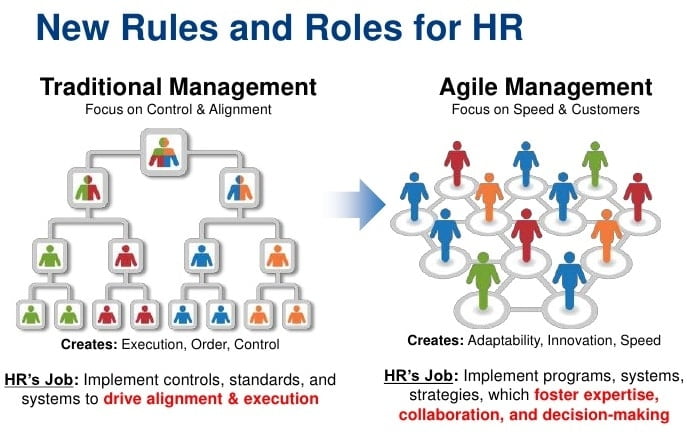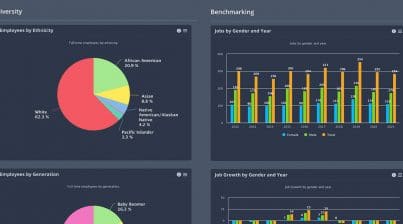Within the past decade, companies have experienced and seen an emerging trend of agile performance management replacing traditional performance management practices. This change has been welcomed by most HR professionals and provided them with key HR data points that have yielded in positive measures for improvement. But what is agile performance management? And how does it differ from traditional performance management? We’ll break down the differences for you and explain exactly how to leverage this emerging trend in HR.
Defining performance management
Performance management refers to the methods that HR managers and executives use to assess key performance indicators (KPIs) and objectives and key results (OKRs). Think of it as an avenue that’s visited occasionally to evaluate the level of progress made on an organization’s goals and objectives.
The idea behind performance management systems came from a talent management philosophy that was developed by Fredrick Taylor. This process involved the various collection of data over relatively distant time frames – such as quarterly, biannually, and annually.
Many individuals that have participated in any form of HR data collection and analysis are familiar with the concept of traditional performance management. This aggregated style of management comes with certain recurring attributes, such as spaced reporting mode. Traditional performance management has an event or formal style of reporting. This coordinated and scheduled method for collecting and assessing data makes it difficult for some using traditional performance management to stay on top of relevant information.

Defining agile performance management
So, if that’s traditional performance management, what’s agile performance management?
Agile performance management is a more fast-paced follow-up and reporting system that yields a higher and more frequent interactive reporting system. When using agile performance management, you don’t have to wait till the end of the year before you can assess your progress and know the next line of actions to take. It focuses on higher engagement and interaction between employees and executives.
Benefits of agile performance management in HR
The results-based, flexible nature of an agile HR style also comes with other benefits that improve both work culture and support organizational objectives to achieve corporate goals. Here are some of these advantages:
- Increased collaboration between executives and employees. With regular reporting and easy access to the progress of KPIs, both company leaders and workers can jointly partake in corporate responsibility. This allows them to feel connected as workers and increases their ability to communicate and collaborate.
- Refreshing company objectives. Agile HR systems utilize the frequency of reporting to support awareness of company goals. As a result, executives and staff are made regularly aware of OKRs and, in the long term, everyone understands their objectives – resulting in improved HR data and productivity.
- Data gives life to the organization. When executives see that HR data reflects their departmental goals, they’re encouraged to do more, and their confidence increases. On the other side of the business, employees can also quickly understand how their actions or inactions have impacted corporate goals.
- Viable HR data is more readily available. Unlike traditional performance management, agile performance management deals with real-time data, allowing both employees and managers to easily assess reports that provide visibility into the organization.
Considerations for implementing agile performance management
Implementing agile performance management requires a transition from the traditional periodic reporting system to a more robust, interactive, and fast-paced HR culture. While it may sound exciting, poorly implementing agile performance management could result in one step forward and two steps back.
The following are a few key considerations for how to properly implement agile performance management:
Set up an agile performance management environment
Given the nature of any performance management system, creating the right tools for a smooth transition into agile performance management is imperative. For an easy transition, it’s better to use tools that emphasize traditional performance management interface and then transition into agile. For example, if an HR manager has quarterly reporting, they could begin to layover more frequent, agile processes.
Also, agile performance management involves the use of automated and semi-automated tools). These tools capture the goals of the organization, OKRs, and feedback.
Set up regular performance check-ins
Agile performance management comes with the need for regular communication, alignment, feedback, and correction. Practically, it’s programmed to prevent problems before they begin. Thus, a vital aspect of the environment, according to this Forbes report, is the need for a quick check-in that allows HR reporters to reach managers and executives and for them to return informed feedback easily.
Create an open feedback channel
An open channel of communication that’s dedicated to aligning with performance objectives is a vital step that keeps employees on track with corporate expectations. It allows for timely assessments and executions. This report shows how employees have positively responded to this system.
Build agile performance around OKRs
OKRs form the crux of performance management. Something must be evaluated at the end of the day and OKRs give us an idea of what that should be. During a transition to agile performance management, all tools and integrations must be built around OKRs and made to show KPIs as an output. If this is captured properly, you can effectively evaluate HR data and performance.
Adjust with the feedback
A great tool can allow HR management to easily spot turnover and areas that need attention in the organization’s workforce. Similarly, HR professionals can quickly adapt and apply strategic human resource management. The concept, which was made popular by Dave Ulrich, advocates for a strategic adaptation of HR to feedback. This would bring about the quicker achievement of goals and make HR more relevant in an organization’s processes.
Graphics design giant, Adobe, implemented a similar system and got incredible results.
How to transition from traditional performance management to agile performance management
The transition from traditional to agile performance management is quite natural. This is because agile performance management uses integrations that are built on traditional performance management.
Essentially, agile performance management is traditional performance management – simply conducted in a different fashion. So, to help you transition from traditional to agile, here are a few points for consideration:
Talk to others in the organization
While agile performance management would seem convenient to pursue, seeking out the opinions of others in the organization, specifically an executive team, would be a good idea before getting started. This will help you understand how to align your organization’s goals with your operational changes by transitioning over to agile.
One step at a time
Allow members of the organization to adopt this new style of performance management. With time, proper explanations, and case studies, you’ll be able to gradually introduce this new concept to them and support its implementation.
Use tools that have easy integrations
Agile performance management is best utilized with tools that staff and executives can easily relate with and easily use. This increases productivity and speed to market.
Using the right tools for agile performance management
Employee Cycle has an HR data dashboard that features an array of information and data points that support an agile approach to performance management. Being able to visualize your data points across multiple systems in a matter of seconds support the agility required to both support the adoption of agile performance management also create fast, productive reporting.
Imagine having a robust platform that helps you easily collect HR data, project the data, and infer suggestions for sound decisions. Receive a free demo of Employee Cycle’s dashboard and see for yourself exactly how easy it is to access data that supports agile performance management.












